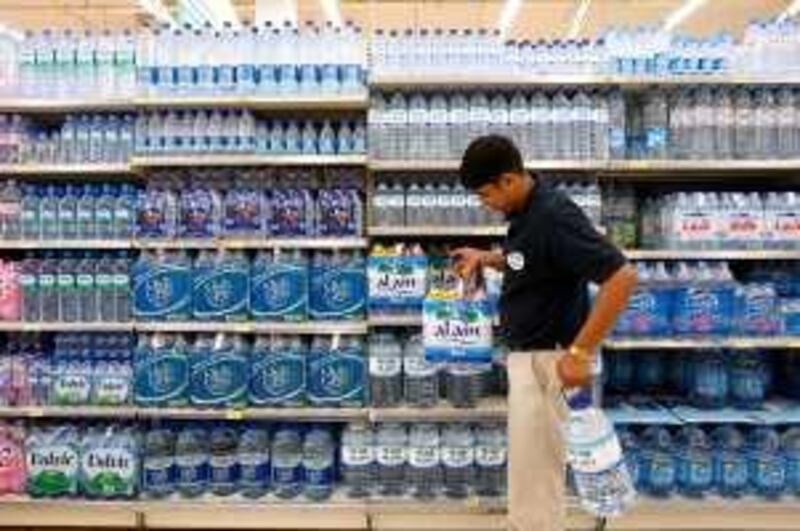Whether you pay Dh250 (US$68.07) for a bottle of Bling H2O or a dirham for a half-litre of Arwa, the list of bottled water on sale in the Emirates is growing at a rapid pace with a wide variety of prices, tastes, contents and sources.
"The size of the potable water market in the UAE is currently valued at Dh1 billion a year, with annual consumption estimated at around 1.2 billion litres," says Fasahat Beg, the general manager of Al Ain Mineral Water. "The UAE is the largest consumer of potable water in the world, with per capita consumption reaching 285 litres per year." Business Monitor International (BMI), a market analysis company, predicts that if the country's insatiable thirst for bottled water continues, the value of the industry will climb to about Dh1.5bn by 2013.
With such a lucrative market, companies are seeking to cater for consumers' needs by tailoring their products or advertising message to attract more people to their brands. That may seem an easy task but a carefully designed message can make the difference between common drinking water and a specialised kind that may be more desirable to consumers. The labels available across the Emirates vary in categories from pure water, purified water, natural water, natural mineral water, natural spring water and more.
Ahmed Tolba, a chemical engineer at Jeema Mineral Water Company, says there are fundamental differences between these categories of bottled water. "Pure water and purified water are basically distilled water, in most cases desalinated water, but sometimes it could be purified groundwater using methods like reverse osmosis," says Mr Tolba. He says natural water basically means groundwater that is filtered and disinfected, and then the required minerals are added to meet human consumption standards.
Natural mineral water is groundwater that has acquired all of the required minerals naturally so it is just filtered and disinfected to make sure it is clean and safe. Natural spring water is just like natural mineral water but from a source that flows. With those distinctions, the question remains as to whether all labels deliver what they promise. "You can never believe anything that's written on any label, because there is always something hidden," says Amna al Haddad, a senior mass communication student at the American University of Sharjah.
Abdul Said Malik, a resident of Dubai, said: "You have to have doubt. In the States they were given tap water in a bottle, and you would think they have strict rules there. But the thing is, where are those natural springs in the UAE?" The answer to that question lies underneath the likes of the Hajar Mountains in Ras al Khaimah and Hatta Mountain in Dubai, where there are sources of natural water used by bottled water companies.
A look at the three leading bottled water producers reveals a correlation between the products and their labels. The topography of the Masafi bottling plant and surrounding areas consists of the Hajar Mountains to the east, farmland to the west, and with low hills scattered around the plant, which is situated near the valley floor. Elevations range between 487 metres above sea level, where the plant is based, and 1,000 metres above sea level at the peaks of the Hajar Mountains.
Within the area lies a diverse network of wadis that extend from the mountains to the low valley areas several kilometres to the south. "The aquifer under Masafi is - rich in alluvial deposits," says Gavin Robello, the assistant manager for management information systems at Masafi. This underground lake is refilled with rainwater that is naturally filtered through rocks. When it rains over the mountains, the water penetrates the ground surface and recharges the fractured aquifer underneath the Masafi bottling plant.
Masafi then extracts the groundwater. But Al Ain Mineral Water is no longer getting water from its deep wells. The company now sources its water from the Al Ain Distribution Company. This water is then purified further in accordance to the health directive from the Abu Dhabi Food Control Authority, passed in 2005, designed to ensure it "conforms to the strict - product guidelines as well as to the internationally accepted US Food and Drug Administration bottled water standards", says Mr Beg.
Jeema uses water that comes from underwater springs in Hatta. The increasing amount of rain in the Emirates brightens the outlook for a better and lasting future for the bottled water business. Rainwater held in dammed lakes across the country following recent downpours is estimated at four million cubic metres, according to a report by the UAE Ministry of Environment and Water. "Rains [that] fell on the northern regions were more than the central and eastern regions," says Ahmed Murad, the head of geology at UAE University.
Mr Murad notes that almost 75 per cent of the rainwater stayed on the surface and only small amounts seeped into the ground. But he says the rainwater will still raise water tables. At the end of the day, whether Dh1 or Dh250, experts agree the thirst for bottled water will continue to rise in the UAE. business@thenational.ae





